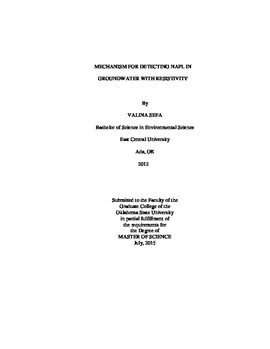| dc.contributor.advisor | Halihan, Todd | |
| dc.contributor.author | Sefa, Valina | |
| dc.date.accessioned | 2016-09-29T18:42:55Z | |
| dc.date.available | 2016-09-29T18:42:55Z | |
| dc.date.issued | 2015-07-01 | |
| dc.identifier.uri | https://hdl.handle.net/11244/45313 | |
| dc.description.abstract | The detection of low concentrations of non-aqueous phase liquids (NAPLs) in freshwater environments by electrical resistivity imaging (ERI) has been clearly demonstrated in field conditions, but the mechanism that generates the resistive signature is poorly understood. An electrical blocking mechanism for detecting low concentrations of non-aqueous phase liquids with electrical resistivity is tested by first developing a theoretical basis for the mechanism, testing the mechanism in a two-dimensional sand tank with electrical resistivity imaging (ERI), and finally performing forward modeling of the laboratory experiment. The NAPL blocking theory assumes that at low bulk saturations, NAPL can block pore throats and generate an electrically resistive signal. The sand tank experiment utilized a photographic technique to quantify petroleum saturation in conjunction with ERI to determine if ERI can detect and quantify NAPL across the water table. This experiment demonstrates that electrical methods can detect NAPL of sufficient thickness with the relationship indicating that the bulk volume of NAPL is not the controlling variable for the amount of resistivity signal generated. The signal is due to a layer with high resistivity blocking current flow through the impacted zone. Thicknesses of impacted zones of 3.3 cm and higher were detected in this tank experiment causing a change in resistivity of 2% and greater. The maximum change in resistivity from the tank experiment was an increase of 37%. Forward models of the experiment confirm the blocking mechanism for the tank experiment. | |
| dc.format | application/pdf | |
| dc.language | en_US | |
| dc.rights | Copyright is held by the author who has granted the Oklahoma State University Library the non-exclusive right to share this material in its institutional repository. Contact Digital Library Services at lib-dls@okstate.edu or 405-744-9161 for the permission policy on the use, reproduction or distribution of this material. | |
| dc.title | Mechanism for Detecting Napl in Groundwater with Resistivity | |
| dc.type | text | |
| dc.contributor.committeeMember | Atekwana, Estella | |
| dc.contributor.committeeMember | Ochsner, Tyson E. | |
| osu.filename | Sefa_okstate_0664M_14099.pdf | |
| osu.accesstype | Open Access | |
| dc.description.department | Environmental Science | |
| dc.type.genre | Thesis | |
